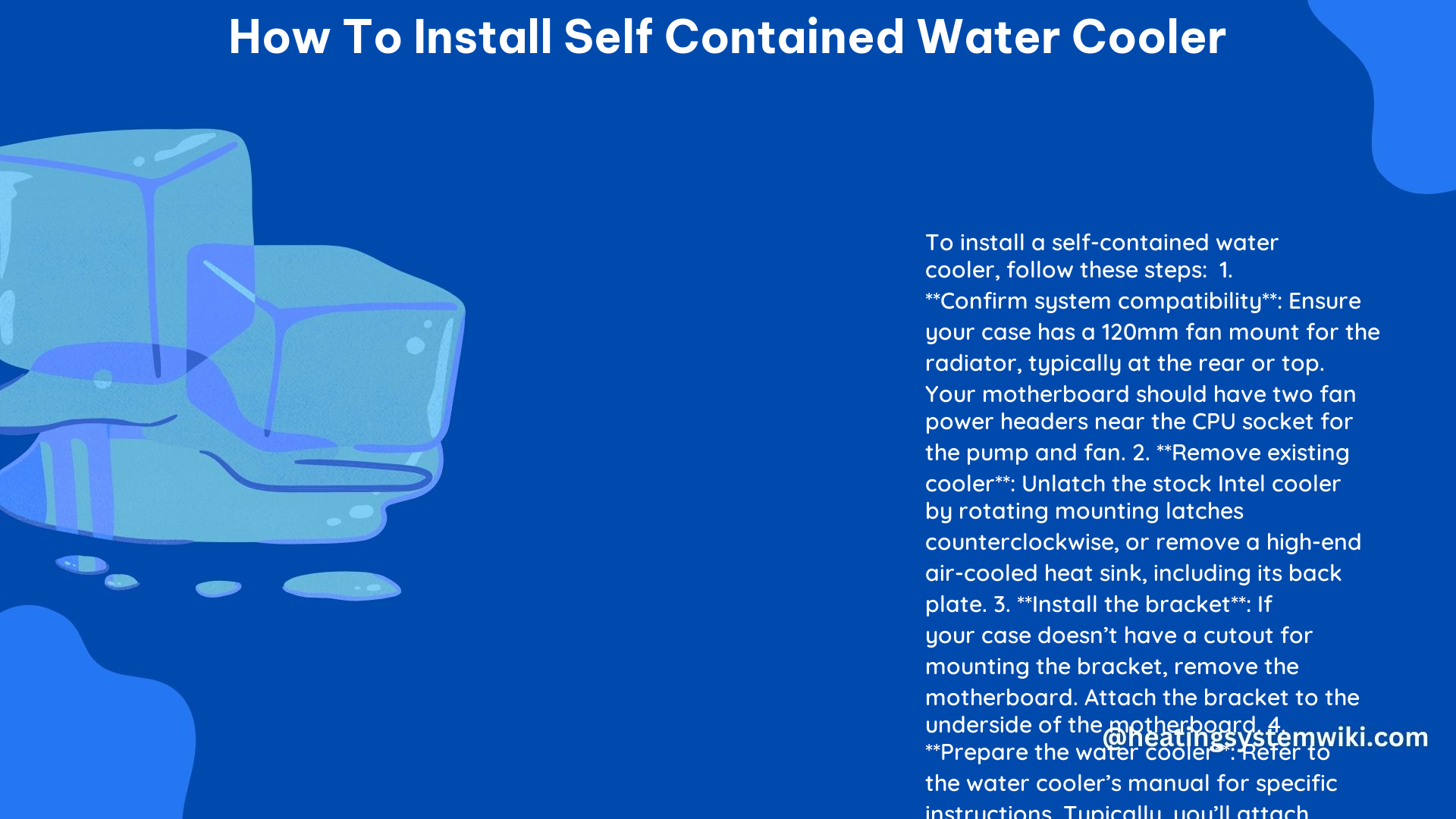Self-contained water coolers, also known as All-In-One (AIO) liquid coolers, are a popular choice for PC enthusiasts looking to upgrade their system’s cooling performance without the complexity of a custom water cooling loop. These pre-assembled, sealed cooling solutions offer a plug-and-play experience, making them an excellent option for those new to liquid cooling. In this comprehensive guide, we’ll walk you through the step-by-step process of installing a self-contained water cooler, covering essential technical details and best practices to ensure a successful and hassle-free installation.
Compatibility Verification
Before you begin the installation process, it’s crucial to ensure that your system’s case and motherboard can accommodate the self-contained water cooler. Here are the key compatibility factors to consider:
- Case Compatibility: Self-contained water coolers typically require a 120mm or 240mm fan mount on the case to accommodate the radiator. Measure the available space in your case to ensure the radiator will fit without any obstructions.
- Motherboard Compatibility: Your motherboard must have two available fan connectors, one for the pump and one for the radiator fan. Additionally, there should be enough clearance on the underside of the motherboard to install the mounting bracket.
- CPU Socket Compatibility: Verify that the water cooler’s mounting bracket is compatible with your CPU socket type, such as LGA 1151, AM4, or others. Consult the manufacturer’s specifications to ensure a proper fit.
Preparation and Component Removal

- Remove Existing Cooling Solution: If you have an existing CPU cooler, whether it’s an air-based heatsink or a previous liquid cooling system, you’ll need to remove it. This may involve unscrewing the mounting bracket and carefully lifting the heatsink off the CPU.
- Remove Case Fan: If your case has a 120mm fan installed in the location where the radiator will be mounted, you’ll need to remove it to make room for the new cooling system.
- Motherboard Removal (Optional): Depending on the design of your case and the water cooler’s mounting bracket, you may need to remove the motherboard to install the bracket. Consult the manufacturer’s instructions for specific guidance.
Radiator and Pump Installation
- Radiator Mounting: Secure the radiator to the designated 120mm or 240mm fan mount on the rear or top of your case, ensuring that the tubing is routed away from any sharp edges or components that could potentially damage it.
- Pump Attachment: Attach the water cooler’s pump unit to the CPU, following the manufacturer’s instructions for proper orientation and securing the mounting bracket. Apply a pea-sized amount of thermal paste to the CPU surface before installing the pump.
- Pump Orientation: Depending on the design of your self-contained water cooler, the pump may need to be oriented in a specific way to ensure proper cooling performance and prevent air bubbles in the system.
Fan and Cabling Connections
- Fan Connections: Connect the radiator fan and the pump fan to the appropriate fan headers on your motherboard, ensuring that they are plugged into the correct connectors (usually labeled as “CPU_FAN” and “CHA_FAN” or similar).
- Pump Connection: Connect the pump’s power cable to a dedicated pump header on the motherboard, if available, or to a standard 4-pin PWM fan header.
- Cable Management: Carefully route the cables and tubing to minimize clutter and potential interference with other components. Use cable ties or cable sleeves to keep the installation tidy.
Filling and Priming the System
- Coolant Filling: If your self-contained water cooler has a refillable reservoir, you’ll need to fill it with the recommended coolant type before powering on the system. Consult the manufacturer’s instructions for the proper filling procedure and coolant specifications.
- Priming the Pump: Once the system is filled, power on the PC and allow the pump to run for a few minutes to ensure that the coolant is circulating properly and that there are no air bubbles in the system.
Final Assembly and Testing
- Reassembly: If you had to remove the motherboard to install the mounting bracket, carefully reinstall the motherboard and secure it in place.
- Power On and Test: Power on your PC and monitor the temperatures of your CPU and other critical components to ensure that the self-contained water cooler is functioning correctly. You may need to adjust the fan and pump speeds in your system’s BIOS or using the manufacturer’s software to optimize cooling performance and noise levels.
Remember, the specific installation steps may vary depending on the model of your self-contained water cooler and the configuration of your system. Always refer to the manufacturer’s instructions for detailed, model-specific guidance.
Additional Considerations
- Radiator Size: Self-contained water coolers typically come with 120mm or 240mm radiators, but larger sizes are also available. Ensure that your case can accommodate the radiator dimensions without any clearance issues.
- Fan and Pump Speed Adjustment: Most self-contained water coolers allow you to adjust the fan and pump speeds to balance cooling performance and noise levels. Experiment with different settings to find the optimal balance for your needs.
- Thermal Paste Application: Some self-contained water coolers come with pre-applied thermal paste, while others require you to apply it yourself. Follow the manufacturer’s instructions for proper thermal paste application to ensure optimal heat transfer between the CPU and the pump.
- Coolant Maintenance: If your self-contained water cooler has a refillable reservoir, you may need to top up the coolant level periodically. Consult the manufacturer’s recommendations for the appropriate coolant type and refilling instructions.
By following these detailed steps and considering the technical specifications, you can successfully install a self-contained water cooler and enjoy the benefits of improved cooling performance for your high-performance PC.
